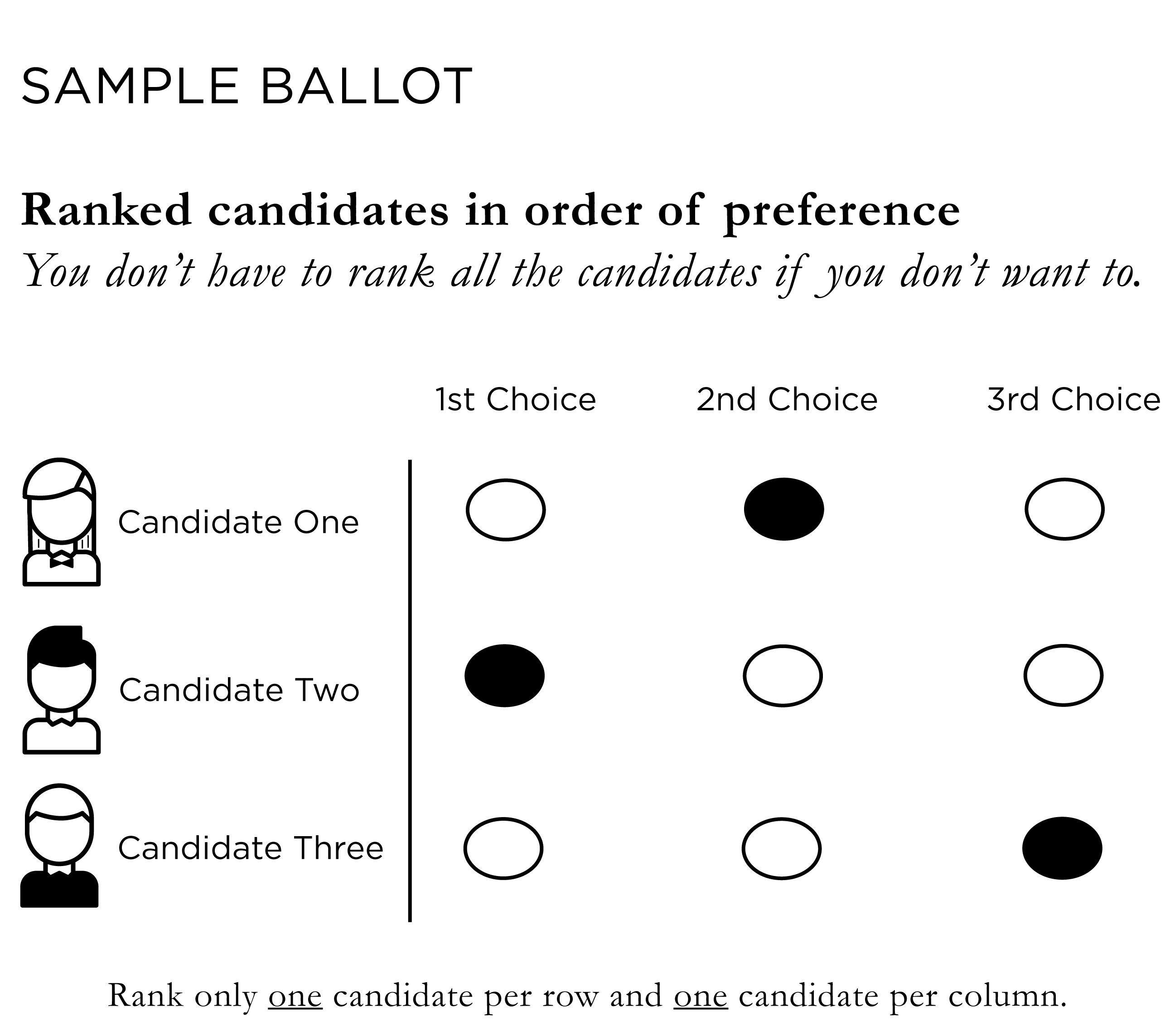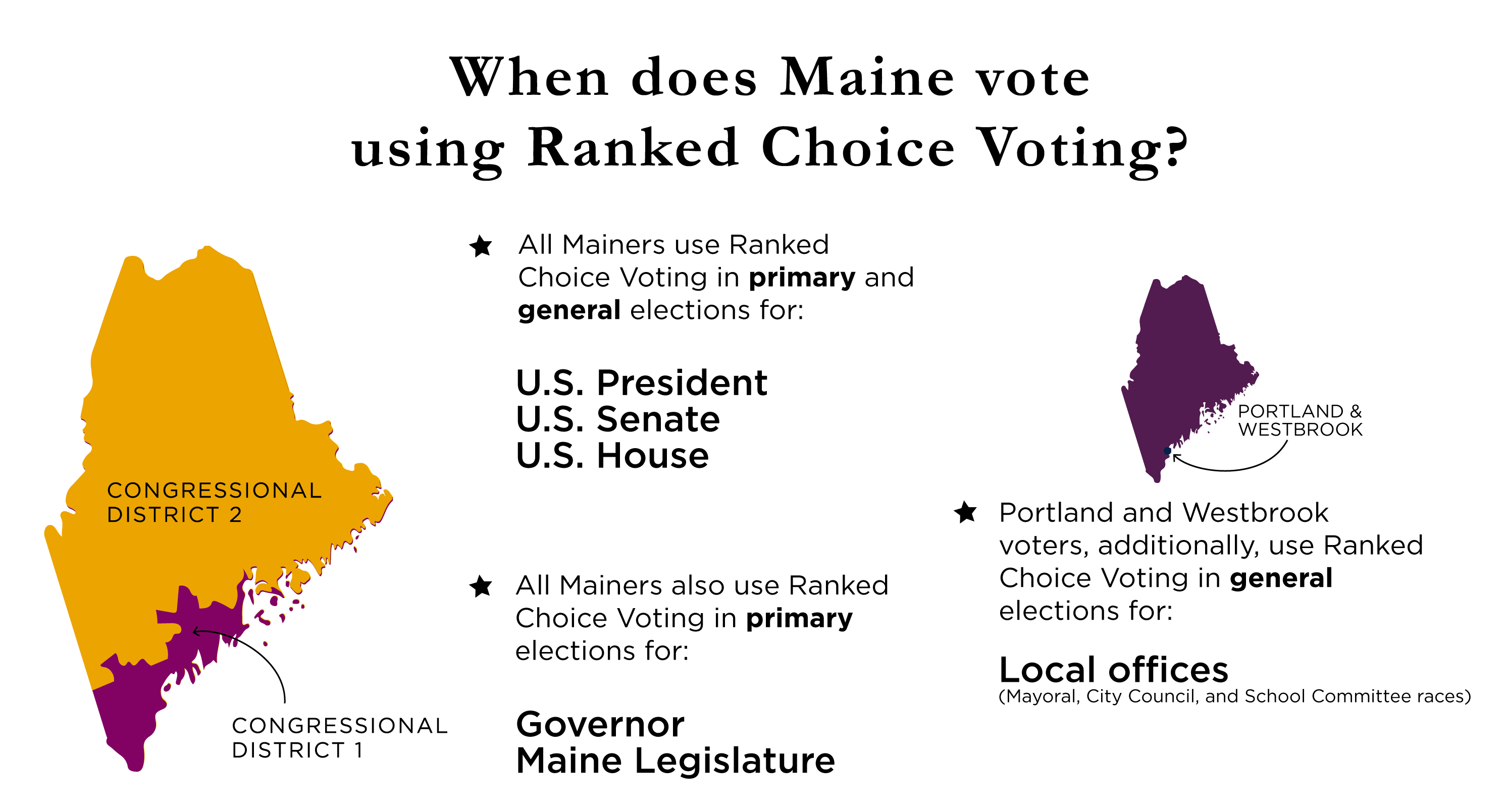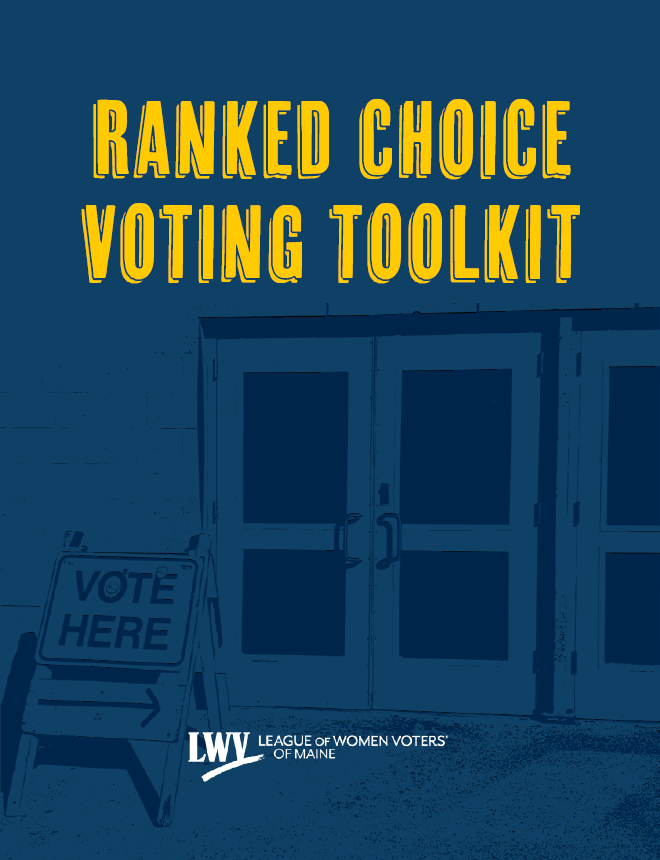How it Works
Ranked choice voting lets voters rank their choices based on individual preference.
First choices are counted, and if no candidate has a majority of the vote, a tabulation occurs in which the candidate with the least support is eliminated. Voters that picked the eliminated candidate as their first choice have their vote counted for their next choice. In a three-person race, we now have a winner with majority support in the final round of tabulation. In a race with more than three candidates, this process is repeated until one candidate has a majority.

Benefits:
- Gives voters more meaningful choices: Ranked choice voting allows candidates from outside the two major parties to compete. It helps create a richer dialogue on the issues and increases the diversity of views available for voters to consider.
- Eliminates spoilers and strategic voting: Ranked choice voting allows voters to support their favorite candidate without worrying that they might "throw their vote away," or worse, split their votes with like‐minded voters and unintentionally help elect the candidate they like the least.
- Reduces negative campaigning: Candidates running in ranked choice elections must ask for second and, sometimes, third choice rankings. Voters are less likely to rank a candidate highly who is negative toward their preferred candidate.
- Reduces the influence of money in politics: Campaigns and special interest groups spend a lot of money on negative advertising. By making negative advertising less effective, ranked choice voting reduces the need for, and influence of, money in politics.
Helpful Videos:
_____________
Related links:
When do we use RCV?
Currently, Maine uses ranked choice voting for both the primary and general elections for our federal delegation and for President of the U.S., but ranked choice voting is only used in the primary elections for state races. Local elections do not use ranked choice voting except in Portland and Westbrook.

Who else uses RCV?
As of December 2022, 63 American jurisdictions have RCV in place, reaching approximately 13 million voters. This includes 2 states, 2 counties, and 59 cities. Military and overseas voters cast RCV ballots in federal runoff elections in 6 states.
-
More than 50 colleges and universities use ranked choice voting for some or all of their student government elections.
- 5 states provide military and overseas voters with ranked choice ballots to participate in federal runoff elections.
- Australia, Ireland, Malta, and New Zealand use ranked choice voting in federal elections.
- Numerous public and private sector organizations, including the Academy of Motion Pictures Arts and Science, use ranked choice voting for their elections.
Read more about who uses RCV.
_____________
Related links:
History of RCV in Maine
First-past-the-post, or plurality voting, works well when there are only two candidates because one of them is guaranteed to win with majority support. But three- and four-way races among competitive candidates are common in Maine and can lead to results where the winner fails to receive a majority of the votes cast (50% + 1). Dating back to 1974, the winner has failed to receive a majority vote in 9 of the last 13 gubernatorial elections in Maine. In 5 of those races, the elections were won with less than 40% support. Given the frequency with which this was happening in Maine elections, the League of Women Voters of Maine convened a study in 2008 to consider alternative voting systems. That study concluded in 2011 with an endorsement of ranked choice voting as the best way to ensure a majority vote in competitive, single-seat, multi-candidate elections.

2016
Ranked choice voting was first put on Maine’s ballot as Question 5 in the 2016 November election after proponents collected more than 70,000 signatures from across the state. Question 5 passed with 52% of the vote.
2017
However, while ranked choice voting was originally intended to apply to all state and federal elections with three or more candidates, an advisory opinion by the Maine Supreme Court in 2017 concluded that RCV conflicted with the plurality language in the Maine State Constitution, which prevented the use of ranked choice voting for legislative and gubernatorial general elections. The Maine Legislature was unable to find a solution to this problem, so legislators passed a bill delaying ranked choice voting.
2018
Supporters of electoral reform collected signatures to place a people’s veto on the ballot in the summer of 2018 to repeal the delaying bill. If passed, it would require ranked choice voting to be maintained. Because placing the people’s veto on the ballot postponed implementation of the delaying law, Maine voters were given the opportunity to vote on whether to preserve ranked choice voting while also using ranked choice voting for several primary races. This people’s veto, called Question 1, was approved by an even greater majority than the original question in 2016.
Much of the time, there's a clear winner in the first round of counting, but the 2018 race for U.S. Congress in District 2 went through an RCV count. Here's official information from the Secretary of State. Ranked choice voting was also used in the Democratic primary elections for governor and the 2nd Congressional District representative. Tabulation for these and other races can be found on the .
2019
The Maine Legislature passed a bill in 2019 expanding ranked choice voting to the presidential race, including both the primary and general elections. Because Maine assigns its electoral college votes by congressional district, ranked choice voting may be applied to determine the winner in each congressional district as well as for the state as a whole. A people’s veto campaign was attempted but did not succeed, and ranked choice voting was used in November 2020.
_____________
Related links:
Municipal RCV
 Ranked Choice Voting Toolkit
Ranked Choice Voting Toolkit
Everyone should feel empowered to bring change to their community. And for those who want to give voters more choice — and more voice — we've published a RCV Toolkit that covers the steps for implementing RCV in your town. We're here to help expand RCV across Maine for municipal elections.
Governor Mills signed LD 859, An Act To Give Municipalities More Options in Municipal Elections, into law in 2022. This bill allows more towns to adopt Ranked Choice Voting (RCV) for municipal elections, like Mayoral, Council, and School Board races. Currently, only Portland and Westbrook use Ranked Choice Voting for municipal elections, but now LD 859 will make it easier for other towns to adopt RCV if they wish to!
The League of Women Voters of Maine has endorsed Ranked Choice Voting since 2011 — after we convened a three year study on the pros and cons of RCV. We concluded RCV is the best way to ensure a majority vote in competitive, single-seat, multi-candidate elections.
_____________












